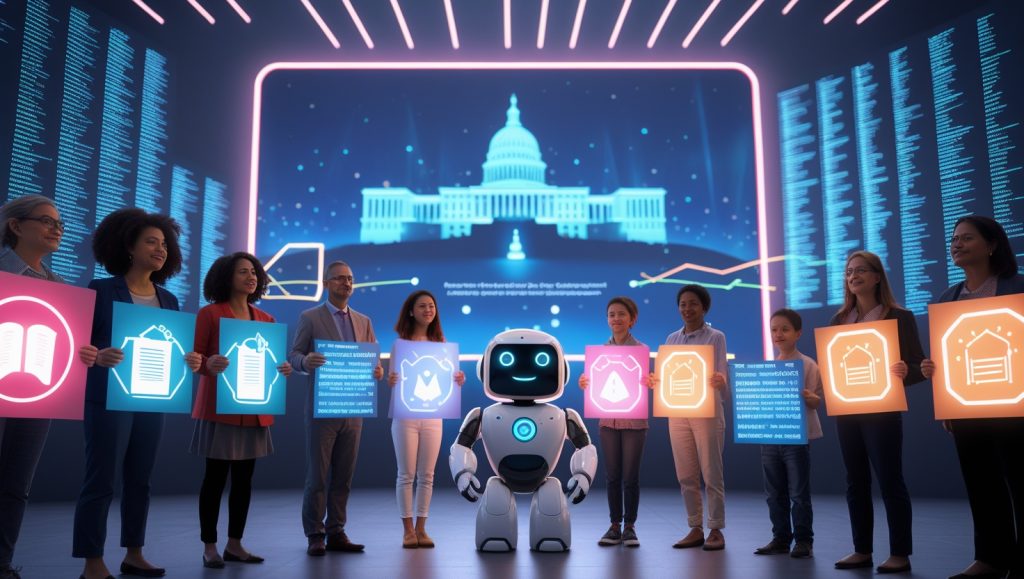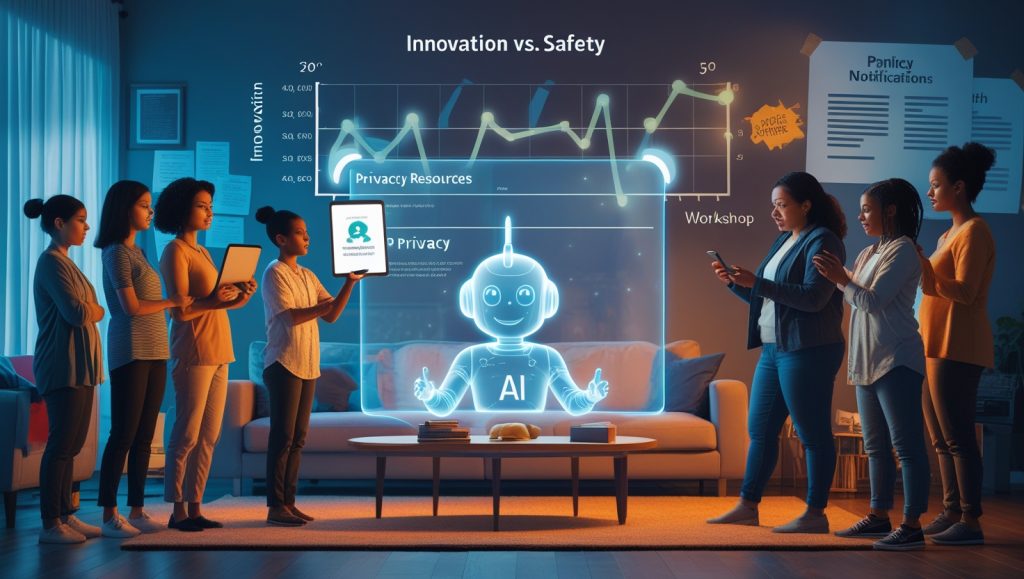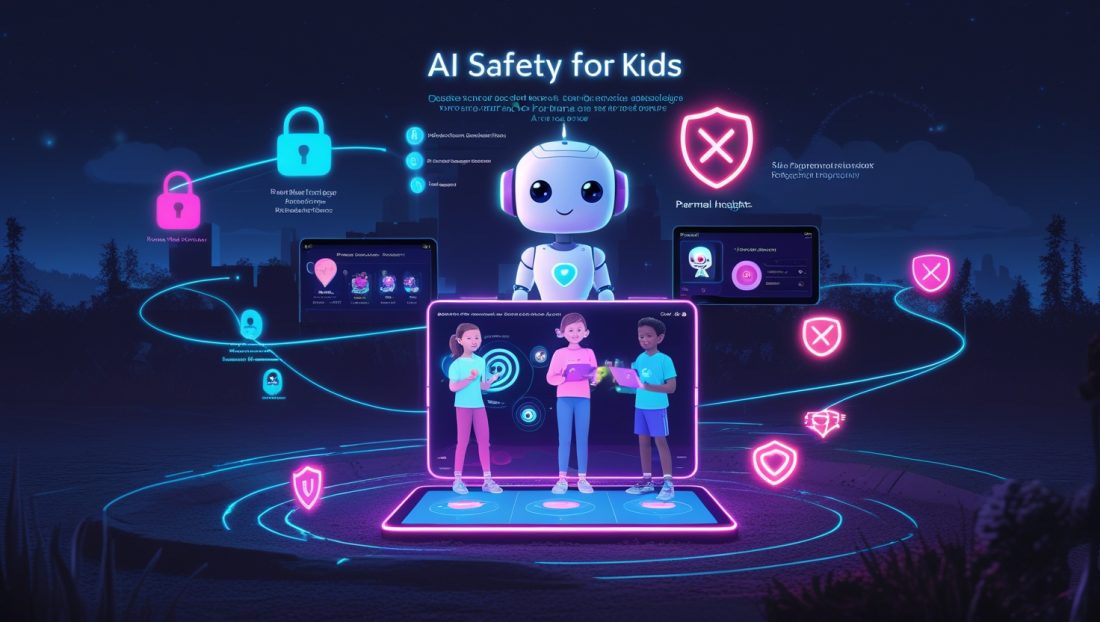Can you imagine a world where your child’s online safety hinges on the actions you take today? In 2025, artificial intelligence (AI) is no longer a distant promise—it’s woven into the fabric of our lives, from virtual assistants to social media algorithms. For children, AI offers boundless opportunities, like tailored education and creative tools. Yet, it also harbors dangers, from deepfake exploitation to unchecked data collection. This is why AI safety for kids has become a rallying cry for parents worldwide. Parental activism in AI safety isn’t just a trend; it’s a movement to shield children in a digital landscape evolving faster than laws can adapt.
Why are parents at the forefront? They witness the risks firsthand—whether it’s a chatbot collecting personal data or an algorithm pushing harmful content. A 2023 Common Sense Media study revealed that 70% of teens use generative AI, yet only a third of parents are aware. This knowledge gap fuels a surge in parental advocacy, demanding ethical AI that prioritizes child safety. In this article, we’ll explore why parental activism is transforming AI safety for kids, the specific threats children face, and how parents can drive change. From real-world examples to actionable steps, we’ll uncover the stakes and the solutions shaping a safer digital future.
Why Parents Are Spearheading AI Safety for Kids

The digital age has thrust parents into a new role: guardians of their children’s online safety. In 2025, the proliferation of generative AI—think chatbots like Grok or image generators like Midjourney—has heightened concerns. Children as young as six navigate these tools with ease, often outpacing their parents’ understanding. A 2017 InternetMatters report noted that six-year-olds were as tech-savvy as ten-year-olds were just three years earlier, a trend that’s only intensified. Parents are now confronting a reality where AI isn’t just a tool—it’s a force shaping their kids’ worldviews, behaviors, and vulnerabilities.
Consider the 2021 Amazon Alexa incident, where the device suggested a 10-year-old touch a live electrical plug with a penny. This mishap exposed AI’s “empathy gap,” a term coined in a 2024 study on child-safe AI design, highlighting systems’ failure to account for children’s unique needs. Parents responded by forming advocacy groups, such as those aligned with Thorn’s Safety by Design initiative, to demand robust safeguards. These groups aren’t just reacting to accidents—they’re proactively tackling issues like data privacy, misinformation, and exploitation to ensure AI safety for kids.
Kate Edwards, an online safety expert at the NSPCC, captures the urgency: “AI tools are embedded in apps kids use daily, but the risks—cyberbullying, grooming, or sexual abuse through misuse—are escalating.” Parental activism is gaining traction because it’s rooted in real-world consequences. From petitioning tech companies to engaging with policymakers, parents are ensuring AI safety for kids isn’t an afterthought but a priority.
For a broader perspective on how technology shapes societal safety, explore how innovative recycling robotics are addressing global sustainability challenges, reflecting the broader impact of tech advocacy.
The Growing Threats of AI to Children in 2025
The dangers AI poses to children are no longer hypothetical—they’re unfolding in real time. Generative AI can produce deepfakes, including AI-generated child sexual abuse material (CSAM). A 2023 Thorn report documented a staggering 104 million suspected CSAM files online, with AI tools amplifying this crisis. Predators use these technologies to impersonate peers or manipulate children, as highlighted by the Child Rescue Coalition. The accessibility of “nudification” apps—AI tools that digitally undress images—has further escalated risks, particularly for girls. In 2025, the UK’s Children’s Commissioner, Dame Rachel de Souza, called for a ban on such apps, citing their role in generating non-consensual explicit images, predominantly targeting women and girls.
Learn more about this issue in our analysis of AI nudification apps and the UK’s new laws, which explores the legal and ethical implications.
Privacy violations are another pressing concern. AI systems collect vast datasets, often without transparent consent. A 2024 UNICEF report warned that children’s data is frequently used to train AI models, risking long-term issues like identity theft or targeted exploitation. For example, a 2023 data breach at a popular educational AI platform exposed the personal information of 1.2 million students, sparking outrage among parents. Mental health is also at stake. The U.S. Surgeon General’s 2024 advisory linked excessive tech use to diminished attention spans and anxiety in teens, with AI-driven algorithms amplifying addictive behaviors through hyper-personalized content.
These threats underscore the urgency of AI safety for kids. Parents are rightly alarmed, as unmonitored AI systems erode trust and safety in digital spaces, pushing them to advocate for stronger protections.
For insights into how tech policies are evolving to address such risks, read about China’s dominance in industrial robotics, which highlights global efforts to regulate technology.
Real-World Example: The Character.AI Controversy
In 2024, Character.AI faced intense scrutiny when parents discovered its teen-focused model lacked adequate parental controls. Teens were engaging with AI characters that could simulate inappropriate conversations, raising concerns about grooming risks. Parental advocacy groups, including Common Sense Media, launched a campaign demanding transparency. By early 2025, Character.AI introduced Parental Insights, a dashboard allowing parents to monitor their teens’ interactions. This victory illustrates how parental pressure can compel tech companies to prioritize AI safety for kids, but it also highlights the ongoing need for vigilance.
Why Parental Advocacy Is Reshaping AI Policy

Parental activism is no longer confined to living rooms—it’s influencing global policy. In 2025, grassroots movements are pushing governments and tech giants to act. The European Union’s Artificial Intelligence Act, set to fully roll out by 2026, classifies educational AI as high-risk, partly due to parental demands for child-specific protections. In the United States, the proposed AI and Kids Initiative, backed by advocacy groups like ParentsTogether, aims to establish a federal framework for AI safety for kids by 2027. These policies reflect parents’ growing influence in ensuring AI aligns with ethical standards.
A notable case is the 2024 backlash against TikTok’s AI-driven content filters. Parents argued that the platform’s algorithms failed to block harmful content, such as eating disorder videos, from reaching teens. Their advocacy led to TikTok’s 2025 commitment to enhance its Trustworthy AI Framework, including stricter content moderation for users under 18. As Tim Estes, CEO of Angel AI, stated, “Parents are the ultimate stakeholders in tech safety—they demand systems that protect, not exploit.” This shift demonstrates how parental voices are forcing accountability.
For a deeper look at how policy shapes tech innovation, check out our exploration of untethered deep-sea robotics, which discusses regulatory challenges in emerging technologies.
Case Study: The UK’s Online Safety Act
The UK’s Online Safety Act, implemented in 2024, mandates platforms to remove illegal content, including AI-generated CSAM. However, parents and advocates, including Dame Rachel de Souza, argue it falls short in addressing tools like nudification apps. Their pressure has led to proposed amendments in 2025, requiring AI developers to conduct risk assessments for child safety before launching products. This case underscores how parental activism bridges the gap between existing laws and emerging threats, ensuring AI safety for kids remains a priority.
How Parents Can Champion AI Safety for Kids
Parents don’t need to be tech wizards to make an impact. The key is proactive engagement, blending education with advocacy. Consider Sarah, a mother from California who joined a local parent group after her son encountered an AI chatbot soliciting personal details. Through workshops hosted by Safer by Design, she learned to monitor her son’s tech use and advocate for stricter app regulations. Her story reflects a growing trend: parents empowering themselves to protect their kids.
Here’s how parents can take action:
- Stay Informed: Resources like the NSPCC’s AI safety guides equip parents with knowledge about risks and solutions. Understanding AI’s capabilities and pitfalls is the first step to advocacy.
- Leverage Technology: Tools like Google Family Link or Qustodio use AI to filter content and set screen time limits. These empower parents to create safe digital environments.
- Engage with Advocacy Groups: Organizations like Thorn and Common Sense Media amplify parental voices, influencing tech policies and corporate practices.
- Foster Open Dialogue: Regular conversations with kids about AI use build trust. Encourage them to report suspicious online interactions, fostering a culture of safety.
- Push for Accountability: Support platforms that prioritize child-safe AI and hold others accountable through petitions or public campaigns.
These steps transform parents from passive users to active stewards of AI safety for kids, ensuring technology serves as a tool for growth, not harm.
Discover how technology is shaping other industries in our analysis of robotics in entertainment by 2030, which explores innovative applications of tech.
Practical Example: The Role of Parental Controls
In 2024, a Texas school district partnered with Bark, an AI-powered monitoring tool, to track students’ online activity. The system flagged instances of harmful AI-generated content, enabling parents to intervene. By 2025, over 500 U.S. schools adopted similar tools, driven by parental demand for real-time oversight. This initiative shows how technology, when guided by parental advocacy, can enhance AI safety for kids.
Personal Story: A Parent’s Wake-Up Call (Fictional)
Last summer, my 13-year-old son, Liam, spent hours chatting with an AI app he found online. It seemed harmless—helping with math homework and even cracking jokes. But one evening, I noticed he’d shared his school’s name and our home address with the app. My stomach dropped. The platform’s privacy policy was vague, and I had no idea who—or what—was collecting his data. (Note: This is a fictional story for illustrative purposes.)
That moment was my wake-up call. I dove into research on AI safety for kids, joined a parent advocacy group, and started using Qustodio to monitor Liam’s devices. We now have regular talks about online safety, and I’ve signed petitions for stricter AI regulations. My journey mirrors countless parents’ experiences—turning fear into action to protect our kids in a digital age.
Challenges and Criticisms of Parental Activism

Parental activism faces significant obstacles. Tech companies often prioritize innovation over safety, resisting calls for stricter controls. A 2024 arXiv study found that parents struggle to monitor AI due to a lack of child-specific tools, forcing reliance on manual oversight. This gap frustrates efforts to ensure AI safety for kids, as parents juggle busy lives with digital vigilance.
Critics also argue that overzealous advocacy could stifle AI’s benefits, such as personalized learning platforms. For instance, Khan Academy’s AI tutor, Khanmigo, has transformed education for millions, but some parents worry about data privacy, creating tension between innovation and safety. Additionally, access to digital literacy resources remains unequal. A 2024 UNICEF report highlighted that parents in low-income communities often lack the tools or knowledge to engage with AI safety, leaving their children more vulnerable.
Despite these challenges, parental activism remains essential. It’s about striking a balance—leveraging AI’s potential while safeguarding kids from its risks.
Addressing Inequality in Digital Literacy
In 2025, initiatives like Google’s Digital Wellbeing program aim to bridge this gap, offering free AI safety workshops in underserved areas. Projected to reach 10 million parents by 2027, these efforts underscore the need for inclusive advocacy. Parental activism must ensure AI safety for kids is accessible to all, regardless of socioeconomic status.
Why the Future of AI Safety for Kids Hinges on Parents
The trajectory of AI safety depends on parents’ continued advocacy. By 2030, AI will be even more pervasive, powering everything from virtual classrooms to gaming ecosystems. Parental activism ensures these systems are designed with children in mind. Take Save the Children’s “Ask Save the Children” AI tool, launched in 2024. It equips educators with child protection resources, a model parents can champion for broader adoption.
The stakes are monumental. As UNICEF’s Steve Vosloo noted, “Children’s needs must shape AI today to secure a safe digital future.” Parents’ demands for transparency, privacy, and fairness will determine whether AI uplifts or endangers kids. Consider the 2025 Global AI Safety Summit, where parental advocacy groups secured a commitment from 20 tech firms to prioritize child-safe AI by 2028. This milestone proves that collective action works.
Parents must remain vigilant, joining groups, supporting policies, and educating their kids. The future of AI safety for kids isn’t just a tech issue—it’s a parental mission.
FAQ: Common Questions About AI Safety for Kids
What is AI safety for kids, and why does it matter?
AI safety for kids involves designing AI systems to protect children from risks like data privacy breaches, harmful content, and exploitation. It matters because kids interact with AI daily, and unchecked systems can lead to real-world harm, from mental health issues to predatory behavior.
How can parents afford AI safety tools?
Many tools, like Google Family Link, are free, while others, like Bark, offer affordable plans starting at $5/month. Nonprofits like Common Sense Media also provide free resources, making AI safety for kids accessible to most families.
Are there laws protecting kids from AI risks?
Yes, laws like the UK’s Online Safety Act and the EU’s AI Act impose safety requirements, but gaps remain. Parental advocacy is pushing for stronger regulations, such as the proposed U.S. AI and Kids Initiative, expected to launch by 2027.
How do I talk to my child about AI safety?
Start with open, age-appropriate conversations. Explain what AI is, highlight risks like sharing personal info, and encourage reporting odd interactions. Resources from the NSPCC offer conversation starters for parents.
Can AI be both safe and beneficial for kids?
Absolutely. AI tools like Khanmigo show how personalized learning can thrive with proper safeguards. Parental activism ensures AI safety for kids balances innovation with protection.
Join the Movement for AI Safety for Kids
Parental activism is reshaping AI safety for kids in 2025, confronting threats like deepfakes, privacy violations, and mental health risks head-on. From influencing policies like the EU’s AI Act to forcing platforms like TikTok to enhance safety, parents are proving their power. Real-world victories, like Character.AI’s Parental Insights, show what’s possible when parents demand change. Yet, challenges persist—tech resistance, digital inequality, and evolving risks require ongoing vigilance.
The future hinges on action. Educate yourself with resources like the NSPCC, use tools like Qustodio, and join groups like Thorn to amplify your voice. Subscribe to CreedTec.online for the latest insights on tech safety and follow our upcoming series on AI’s role in education. Together, we can ensure AI safety for kids isn’t just a goal—it’s a reality. Will you join the movement?
